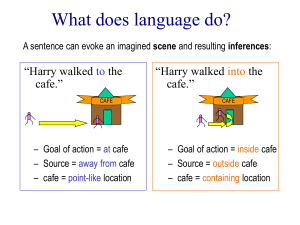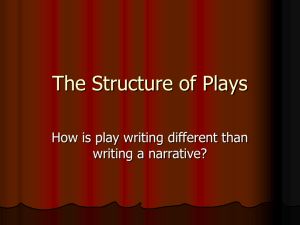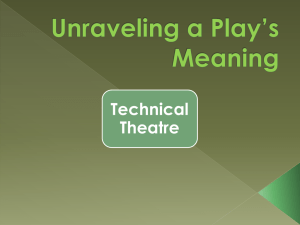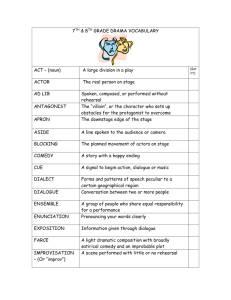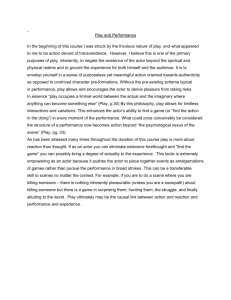Getting From the Utterance to the SemSpec Johno Bryant
advertisement
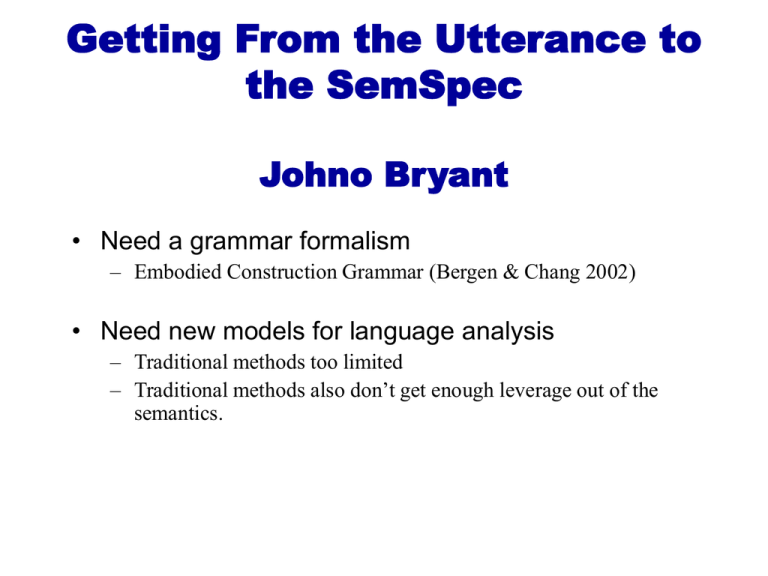
Getting From the Utterance to
the SemSpec
Johno Bryant
• Need a grammar formalism
– Embodied Construction Grammar (Bergen & Chang 2002)
• Need new models for language analysis
– Traditional methods too limited
– Traditional methods also don’t get enough leverage out of the
semantics.
Embodied Construction
Grammar
• Semantic Freedom
– Designed to be symbiotic with cognitive approaches to
meaning
– More expressive semantic operators than traditional
grammar formalisms
• Form Freedom
– Free word order, over-lapping constituency
• Precise enough to be implemented
Traditional Parsing Methods
Fall Short
• PSG parsers too strict
– Constructions not allowed to leave constituent order
unspecified
• Traditional way of dealing with incomplete
analyses is ad-hoc
– Making sense of incomplete analyses is important when
an application must deal with “ill-formed” input
(For example, modeling language learning)
• Traditional unification grammar can’t handle
ECG’s deep semantic operators.
Our Analyzer
• Replaces the FSMs used in traditional chunking
(Abney 96) with much more powerful machines
capable of backtracking called construction
recognizers
• Arranges these recognizers into levels just like in
Abney’s work
• But uses a chart to deal with ambiguity
Our Analyzer (cont’d)
• Uses specialized feature structures to deal with
ECG’s novel semantic operators
• Supports a heuristic evaluation metric for finding
the “right” analysis
• Puts partial analyses together when no complete
analyses are available
– The analyzer was designed under the assumption that the
grammar won’t cover every meaningful utterance
encountered by the system.
System Architecture
Grammar/Utterance
Semantic
Chunker
Learner
Semantic
Integration
Ranked Analyses
The Levels
• The analyzer puts the recognizer on the level
assigned by the grammar writer.
– Assigned level should be greater than or equal to the levels
of the construction’s constituents.
• The analyzer runs all the recognizers on level 1,
then level 2, etc. until no more levels.
• Recognizers on the same level can be mutually
recursive.
Recognizers
• Each Construction is turned into a recognizer
• Recognizer = active representation
– seeks form elements/constituents when initiated
– Unites grammar and process - grammar isn’t just a static
piece of knowledge in this model.
• Checks both form and semantic constraints
– Contains an internal representation of both the semantics
and the form
– A graph data structure used to represent the form and a
feature structure representation for the meaning.
Recognizer Example
Mary kicked the ball into the net.
This is the initial Constituent
Graph for caused-motion.
Agent
Patient
Action
Path
Recognizer Example
Construct:
Caused-Motion
Constituent:
Agent
Constituent:
Action
Constituent:
Patient
Constituent:
Path
The initial constructional tree for the instance of
Caused-Motion that we are trying to create.
Recognizer Example
caused motion.m
patient.m
agent : 5
agent.m
, 3category :
, 1category :
scene : 4
resolved ref : resolved ref :
action : 6
caused motion.cm
path.m
agent : 15
source :
action.m
, 2tense :
4 patient : {3}{cm1} ,{7} path :
x schema :
action : 26
goal :
path : {7}
trajector : {cm1}
Recognizer Example
processed
Mary kicked the ball into the net.
A node filled with gray is removed.
Patient
Agent
Action
Path
Recognizer Example
Construct:
Caused-Motion
RefExp:
Mary
Constituent:
Action
Constituent:
Patient
Constituent:
Path
Mary kicked the ball into the net.
Recognizer Example
caused motion.m
patient.m
agent : 5
agent.m
, 3category :
, 1category : Person
scene : 4
resolved ref : Mary resolved ref
action : 6
caused motion.cm
path.m
agent : 15
source :
action.m
, 2tense :
4 patient : {3}{cm1} ,{7} path :
x schema :
action : 26
goal :
path : {7}
trajector : {cm1}
:
Recognizer Example
processed
Mary kicked the ball into the net.
Patient
Agent
Action
Path
Recognizer Example
Construct:
Caused-Motion
RefExp:
Mary
Verb:
kicked
Constituent:
Patient
Constituent:
Path
Mary kicked the ball into the net.
Recognizer Example
caused motion.m
patient.m
agent : 5
agent.m
, 3category :
, 1category : Person
scene : 4
resolved ref : Mary resolved ref :
action : 6
caused motion.cm
path.m
agent : 15
source :
action.m
, 2tense : simpPast
4 patient : {3}{cm1} ,{7} path :
x schema : kick
action : 26
goal :
path : {7}
trajector : {cm1}
Recognizer Example
processed
Mary kicked the ball into the net.
According to the Constituent Graph,
The next constituent can either be the
Patient or the Path.
Agent
Patient
Action
Path
Recognizer Example
processed
Mary kicked the ball into the net.
Patient
Agent
Action
Path
Recognizer Example
Construct:
Caused-Motion
RefExp:
Mary
Verb:
kicked
Det
RefExp:
Det Noun
Constituent:
Path
Noun
Mary kicked the ball into the net.
Recognizer Example
caused motion.m
patient.m
agent : 5
agent.m
, 3category : ball
, 1category : Person
scene : 4
resolved ref : Mary resolved ref :
action : 6
caused motion.cm
path.m
agent : 15
source :
action.m
, 2tense : simpPast
4 patient : {3}{cm1} ,{7} path :
x schema : kick
action : 26
goal :
path : {7}
trajector : {cm1}
Recognizer Example
processed
Mary kicked the ball into the net.
Patient
Agent
Action
Path
Recognizer Example
Construct:
Caused-Motion
RefExp:
Mary
Verb:
kicked
RefExp:
Det Noun
Spatial-Pred:
Prep RefExp
RefExp
Det
Noun
Prep
Det
Noun
Mary kicked the ball into the net.
Recognizer Example
caused motion.m
patient.m
agent : 5
agent.m
, 3category : ball
, 1category : Person
scene : 4
resolved ref : Mary resolved ref :
action : 6
caused motion.cm
path.m
agent : 15
source :
action.m
, 2tense : simpPast
4 patient : {3}{cm1} ,{7} path :
x schema : kick
action : 26
goal : net
path : {7}
trajector : {cm1}
Resulting SemSpec
After analyzing the sentence, the following identities
are asserted in the resulting SemSpec:
Scene = Caused-Motion
Agent = Mary
Action = Kick
Patient = Path.Trajector = The Ball
Path = Into the net
Path.Goal = The net
Chunking
L3 ________________________S_____________S
L2 ____NP _________PP
VP
NP ______VP
L1 ____NP P_______NP
VP
NP ______VP
L0 D
0
N
P D N
N V-tns Pron Aux V-ing
the woman in the lab coat thought you were sleeping
1
2 3
Cite/description
4
5
6
7
8
9
Construction Recognizers
Form
Meaning
Form
Meaning
D,N <-> [Cloth
“you”<->[Addressee]
num:sg]
NP
You
NP
want to put
NP
a cloth
Like Abney:
One recognizer per rule
Bottom up and level-based
NP
on
Form
Meaning
PP$,N <-> [Hand
num:sg
poss:addr]
NP
your hand
?
Unlike Abney:
Check form and semantics
More powerful/slower than FSMs
Chunk Chart
• Interface between chunking and structure
merging
• Each edge is linked to its corresponding
semantics.
You
want to put
a cloth
on
your hand
?
Combining Partial Parses
• Prefer an analysis that spans the input utterance
with the minimum number of chunks.
• When no spanning analysis exists, however, we
still have a chart full of semantic chunks.
• The system tries to build a coherent analysis out of
these semantics chunks.
• This is where structure merging comes in.
Structure Merging
• Closely related to abductive inferential mechanisms
like abduction (Hobbs)
• Unify compatible structures (find fillers for frame
roles)
• Intuition: Unify structures that would have been coindexed had the missing construction been defined.
• There are many possible ways to merge structures.
• In fact, there are an exponential number of ways to
merge structures (NP Hard). But using heuristics
cuts down the search space.
Structure Merging Example
Utterance:You used to hate to have the bib put on .
Before Merging:
[Addressee < Animate]
Bib < Clothing
num:sg
givenness:def
Caused-Motion-Action
Agent: [Animate]
Patient: [Entity]
Path:On
After Merging:
Caused-Motion-Action
Agent: [Addressee]
Patient:
Bib < Clothing
num:sg
givenness:def
Path:On
Semantic Density
• Semantic density is a simple heuristic to choose
between competing analyses.
• Density of an analysis = (filled roles) / (total roles)
• The system prefers higher density analyses
because a higher density suggests that more frame
roles are filled in than in competing analyses.
• Extremely simple / useful? but it certainly can be
improved upon.
Summary: ECG
• Linguistic constructions are tied to a model of
simulated action and perception
• Embedded in a theory of language processing
– Constrains theory to be usable
– Frees structures to be just structures, used in processing
• Precise, computationally usable formalism
– Practical computational applications, like MT and NLU
– Testing of functionality, e.g. language learning
• A shared theory and formalism for different
cognitive mechanisms
– Constructions, metaphor, mental spaces, etc.
Issues in Scaling up to Language
• Knowledge
–
–
–
–
Lexicon (FrameNet)
Constructicon (ECG)
Maps (Metaphors, Metonymies) (MetaNet)
Conceptual Relations (Image Schemas, X-schemas)
• Computation
– Representation (ECG)
• expressiveness, modularity, compositionality
– Inference (Simulation Semantics)
• tractable, distributed, probabilistic concurrent, contextsensitive
A Best-Fit Approach for Productive
Analysis of Omitted Arguments
Eva Mok & John Bryant
University of California, Berkeley
International Computer Science Institute
Simplify grammar by exploiting the
language understanding process
•
•
•
•
Omission of arguments in Mandarin Chinese
Construction grammar framework
Model of language understanding
Our best-fit approach
Productive Argument Omission (in Mandarin)
1
2
3
4
ma1+ma gei3 ni3 zhei4+ge • Mother (I) give you this (a
toy).
mother give 2PS this+CLS
ni3 gei3 yi2 • You give auntie [the peach].
2PS give auntie
ao ni3 gei3 ya
EMP 2PS give EMP
• Oh (go on)! You give [auntie] [that].
gei3 • [I] give [you] [some peach].
give
CHILDES Beijing Corpus (Tardiff, 1993; Tardiff, 1996)
Arguments are omitted with different
probabilities
% elided (98 total utterances)
100.00%
90.00%
80.00%
Giver
Theme
70.00%
60.00%
50.00%
Recipient
40.00%
30.00%
20.00%
10.00%
0.00%
All arguments omitted: 30.6%
omitted: 6.1%
No arguments
Construction grammar approach
• Kay & Fillmore 1999; Goldberg 1995
• Grammaticality: form and function
• Basic unit of analysis: construction,
i.e. a pairing of form and meaning constraints
• Not purely lexically compositional
• Implies early use of semantics in processing
• Embodied Construction Grammar (ECG) (Bergen &
Chang, 2005)
Problem: Proliferation of constructions
Subj
Verb
Obj1
Obj2
↓
↓
↓
↓
Giver
Transfer Recipient
Theme
Verb
Obj1
Obj2
↓
↓
↓
Transfer Recipient
Theme
Subj
Verb
Obj2
↓
↓
↓
Giver
Transfer
Theme
Subj
Verb
Obj1
↓
↓
↓
Giver
Transfer Recipient
…
If the analysis process is smart, then...
Subj
Verb
Obj1
Obj2
↓
↓
↓
↓
Giver
Transfer Recipient
Theme
• The grammar needs only state one construction
• Omission of constituents is flexibly allowed
• The analysis process figures out what was omitted
Best-fit analysis process takes burden
off the grammar representation
Utterance
Discourse & Situational
Context
Constructions
Analyzer:
incremental,
competition-based,
psycholinguistically
plausible
Semantic Specification:
image schemas, frames,
action schemas
Simulation
Competition-based analyzer finds
the best analysis
• An analysis is made up of:
– A constructional tree
– A set of resolutions
– A semantic specification
The best fit has the
highest combined score
Combined score that determines
best-fit
• Syntactic Fit:
– Constituency relations
– Combine with preferences on non-local elements
– Conditioned on syntactic context
• Antecedent Fit:
– Ability to find referents in the context
– Conditioned on syntactic information, feature agreement
• Semantic Fit:
– Semantic bindings for frame roles
– Frame roles’ fillers are scored
Analyzing ni3 gei3 yi2 (You give auntie)
Two of the competing analyses:
ni3
↓
Giver
gei3
↓
yi2
↓
omitted
↓
Transfer Recipient Theme
ni3
↓
Giver
gei3
↓
omitted
↓
Transfer Recipient Theme
• Syntactic Fit:
– P(Theme omitted | ditransitive cxn) = 0.65
– P(Recipient omitted | ditransitive cxn) = 0.42
(1-0.78)*(1-0.42)*0.65 = 0.08
yi2
↓
(1-0.78)*(1-0.65)*0.42 = 0.03
Using frame and lexical information
to restrict type of reference
The Transfer Frame
Giver
Lexical Unit gei3
Recipient
Giver
(DNI)
Theme
Recipient
(DNI)
Theme
(DNI)
Manner
Means
Place
Purpose
Reason
Time
Can the omitted argument be
recovered from context?
• Antecedent Fit:
ni3
↓
Giver
gei3
yi2
omitted
↓
↓
↓
Transfer Recipient Theme
ni3
↓
Giver
gei3
omitted
yi2
↓
↓
↓
Transfer Recipient Theme
Discourse & Situational
Context
child
peach
table
mother
auntie
?
How good of a theme is a peach?
How about an aunt?
• Semantic Fit:
ni3
↓
Giver
gei3
yi2
omitted
↓
↓
↓
Transfer Recipient Theme
ni3
↓
Giver
gei3
omitted
yi2
↓
↓
↓
Transfer Recipient Theme
The Transfer Frame
Giver
(usually animate)
Recipient
(usually animate)
Theme
(usually inanimate)
The argument omission patterns shown earlier
can be covered with just ONE construction
% elided (98 total utterances)
90.00%
80.00%
Giver
Theme
70.00%
60.00%
50.00%
Subj
P(omitted|cxn):
Verb
Obj1
Obj2
↓
↓
↓
↓
Giver
Transfer
Recipient
Theme
0.42
0.65
0.78
40.00%
30.00%
20.00%
10.00%
0.00%
• Each cxn is annotated with probabilities of omission
• Language-specific default probability can be set
Recipient
Leverage process to simplify
representation
• The processing model is complementary to the
theory of grammar
• By using a competition-based analysis process, we
can:
– Find the best-fit analysis with respect to constituency
structure, context, and semantics
– Eliminate the need to enumerate allowable patterns of
argument omission in grammar
• This is currently being applied in models of
language understanding and grammar learning.
Embodied Compositional
Semantics
Ellen Dodge
edodge@berkeley.edu
March 9, 2007
Questions
• What is the nature of compositionality in
the Neural Theory of Language?
• How can it be best represented using
Embodied Construction Grammar?
Examples
•
•
•
•
•
•
•
He bit the apple
He was bitten (by a toddler)
He bit into the apple
His white teeth bit into the apple.
He shattered the window
The window was shattered
The window shattered
Outline
• Compositionality
• Neural Theory of Language and ECG
– Assumptions
– Overview
• Examples:
– Representation of constructions and meaning
– Simulation
• Concluding Remarks
Compositionality
• Put the parts together to create the meaning of
the whole.
Compositionality
• Put the parts together to create the meaning of
the whole.
• Questions:
– what is the nature of the parts?
– How and why do they combine with one another?
– What meaning is associated with this composition?
Short answers
• Parts = constructions, schemas
• Combination = binding, unification
• Meaning of the whole = simulation of
unified parts
Constructions
Construction Grammar
• Constructions are form-meaning pairings
• A given utterance instantiates many different
constructions
Embodied Construction Grammar
• Construction meaning is represented using
schemas
• Meaning is embodied
Key assumptions of NTL
• Language understanding is simulation
• Simulation involves activation of neural
structures
Comments
• Language understanding
• Understanding process is dynamic
• “Redundancy” is okay
Conceptual structure
•
•
•
•
Embodied
Schematic
(Potentially) language-independent
Highly interconnected
Simulation parameters
• Constructions unify to create semantic
specification that supports a simulation
• Two types of simulation parameters for
event descriptions:
– Event content
– Event construal
Putting the parts together
• Bindings
• Unification
“Pre-existing” structure
schema
Cxn
schema
schema
schema
schema
Cxn
Cxn
Unification
schema
Cxn
schema
schema
schema
schema
Cxn
Cxn
Summary
• Parts = constructions, schemas
• Combination = binding, unification
• Meaning of the whole = simulation of the
combined parts
First example
• He bit the apple.
Schemas
schema MotorControl
subcase of Process
roles
Actor ↔ Protagonist
Effector
Effort
Routine
constraints
Actor ← animate
schema Contact
subcase of SpatialRelation
roles
Entity1: entity
Entity2: entity
schema ForceTransfer
evokes Conact as C
roles
Supplier ↔ C.entity1
Recipient ↔ C.entity2
Force
schema MotorControl
subcase of Process
roles
Actor ↔ Protagonist
Effector
Effort
Routine
constraints
Actor ← animate
schema ForceApplication
subcase of MotorControl
evokes ForceTransfer as FT
roles
Actor ↔ FT.Supplier ↔ Protagonist
Acted Upon↔ FT.Recipient
Effector
Routine
Effort ↔ FT.Force.amount
Schema networks
Contact
MotorControl
ForceTransfer
Motion
ForceApplication
CauseEffect
Effector
Motion
SelfMotion
MotionPath
Effector
MotionPath
Agentive Impact
SPG
SpatiallyDirectedAction
SelfMotion
Path
Contact
Verb Constructions
Construction BITE1
subcase of Verb
form: bite
meaning: ForceApplication
constraints:
Effector ← teeth
Routine ← bite // close mouth
schema ForceApplication
subcase of MotorControl
evokes ForceTransfer as FT
roles
Actor ↔ FT.Supplier ↔ Protagonist
Acted Upon ↔ FT.Recipient
Effector
Routine
Effort ↔ FT.Force.amount
Verb Constructions
cxn BITE
meaning: ForceApplication
cxn GRASP
meaning: ForceApplication
cxn PUSH
meaning: ForceApplication
cxn SLAP
meaning: AgentiveImpact
cxn KICK
meaning: AgentiveImpact
cxn HIT
meaning: AgentiveImpact
schema MotorControl
schema ForceApplication
subcase of MotorControl
schema Agentive Impact
subcase of ForceApplication
Argument Structure Construction
construction ActiveTransitiveAction2
subcase of VP
constituents:
V : verb
NP: NP
form
constraints:
VF before NPF
meaning: CauseEffect
evokes; EventDescriptor as ED; ForceApplication as FA
constraints:
{Selfm ↔ ED.EventType}
{Vm ↔ ED.ProfiledProcess}
Causer ↔ ED.ProfiledParticipant
FA ↔ Vm
Causer ↔ FA.Actor
Affected ↔ FA.ActedUpon
Affected ↔ NPm
Argument Structure Construction
construction ActiveTransitiveAction2
subcase of VP
constituents:
V : verb
NP: NP
form
constraints:
VF before NPF
meaning: CauseEffect
evokes; EventDescriptor as ED; ForceApplication as FA
constraints:
{Selfm ↔ ED.EventType}
{Vm ↔ ED.ProfiledProcess}
Causer ↔ ED.ProfiledParticipant
FA ↔ Vm
Causer ↔ FA.Actor
Affected ↔ FA.ActedUpon
Affected ↔ NPm
CauseEffect schema
schema CauseEffect
subcase of ForceApplication; Process
roles
Causer ↔ Actor
Affected ↔ ActedUpon ↔ Process.Protagonist
Instrument ↔ Effector
Schema Network
Contact
MotorControl
Process
ForceTransfer
Motion
ForceApplication
CauseEffect
Effector
Motion
SelfMotion
MotionPath
Effector
MotionPath
Agentive Impact
SPG
SpatiallyDirectedAction
SelfMotion
Path
Contact
Argument Structure Construction
construction ActiveTransitiveAction2
subcase of VP
constituents:
V : verb
NP: NP
form
constraints:
VF before NPF
meaning: CauseEffect
evokes: EventDescriptor as ED; ForceApplication as FA
constraints:
{Selfm ↔ ED.EventType}
{Vm ↔ ED.ProfiledProcess}
Causer ↔ ED.ProfiledParticipant
FA ↔ Vm
Causer ↔ FA.Actor
Affected ↔ FA.ActedUpon
Affected ↔ NPm
Schema Network
Contact
MotorControl
Process
ForceTransfer
Motion
ForceApplication
CauseEffect
Effector
Motion
SelfMotion
MotionPath
Effector
MotionPath
Agentive Impact
SPG
SpatiallyDirectedAction
SelfMotion
Path
Contact
Important points
Compositionality does not require that each
component contain different information.
Shared semantic structure is not viewed as
an undesirable redundancy
Argument Structure Construction
construction ActiveTransitiveAction2
subcase of VP
constituents:
V : verb
NP: NP
form
constraints:
VF before NPF
meaning: CauseEffect
evokes; EventDescriptor as ED; ForceApplication as FA
constraints:
{Selfm ↔ ED.EventType}
{Vm ↔ ED.ProfiledProcess}
Causer ↔ ED.ProfiledParticipant
FA ↔ Vm
Causer ↔ FA.Actor
Affected ↔ FA.ActedUpon
Affected ↔ NPm
Event Descriptor schema
schema EventDescriptor
roles
EventType: Process
ProfiledProcess: Process
ProfiledParticipant: Entity
ProfiledState(s): State
SpatialSetting
TemporalSetting
Argument Structure Construction
Construction ActiveTransitiveAction2
subcase of VP
constituents:
V : verb
NP: NP
form
constraints:
VF before NPF
meaning: CauseEffect
evokes; EventDescriptor as ED; ForceApplication as FA
constraints:
{Selfm ↔ ED.EventType}
{Vm ↔ ED.ProfiledProcess}
Causer ↔ ED.ProfiledParticipant
FA ↔ Vm
Causer ↔ FA.Actor
Affected ↔ FA.ActedUpon
Affected ↔ NPm
Bindings with other cxns
construction NPVP1
constituents:
Subj: NP
VP : VP
form
Constraints
Subj f before VPf
meaning: EventDescriptor
ProfiledParticipant ↔ Subjm
construction ActiveTransitiveAction2
subcase of VP
constituents: V ; NP
form: VF before NPF
meaning: CauseEffect
evokes; EventDescriptor as ED
constraints:
{Selfm ↔ ED.EventType}
{Vm ↔ ED.ProfiledProcess}
Causer ↔ ED.ProfiledParticipant
Affected ↔ NPm
Bindings with other cxns
Construction NPVP1
constituents:
Subj: NP
VP : VP
form
constraints
Subj f before VPf
meaning: EventDescriptor
ProfiledParticipant ↔ Subjm
schema EventDescriptor
roles
EventType
ProfiledProcess
ProfiledParticipant
ProfiledState(s)
SpatialSetting
TemporalSetting
construction ActiveTransitiveAction2
subcase of VP
constituents: V ; NP
form: VF before NPF
meaning: CauseEffect
evokes; EventDescriptor as ED
constraints:
{Selfm ↔ ED.EventType}
{Vm ↔ ED.ProfiledProcess}
Causer ↔ ED.ProfiledParticipant
Affected ↔ NPm
Bindings with other cxns
construction NPVP1
constituents:
Subj: NP
VP : VP
form
Constraints
Subj f before VPf
meaning: EventDescriptor
ProfiledParticipant ↔ Subjm
schema EventDescriptor
roles
EventType
ProfiledProcess
ProfiledParticipant
ProfiledState(s)
SpatialSetting
TemporalSetting
construction ActiveTransitiveAction2
subcase of VP
constituents: V ; NP
form: VF before NPF
meaning: CauseEffect
evokes; EventDescriptor as ED
constraints:
{Selfm ↔ ED.EventType}
{Vm ↔ ED.ProfiledProcess}
Causer ↔ ED.ProfiledParticipant
Affected ↔ NPm
Unification
Meaning
EventDescriptor
EventType
ProfiledProcess
ProfiledParticipant
Constructions
NPVP1
CauseEffect
causer
affected
TransitiveAction2
ForceApplication
actor
actedupon
BITE
NP2
ReferentDescriptor
THE
ReferentDescriptor
NP1
HE
APPLE
Unification
Meaning
EventDescriptor
EventType
ProfiledProcess
ProfiledParticipant
Constructions
NPVP1
CauseEffect
causer
affected
TransitiveAction2
ForceApplication
actor
actedupon
BITE
NP2
ReferentDescriptor
THE
ReferentDescriptor
resolved referent
NP1
HE
APPLE
Unification
Meaning
EventDescriptor
eventtype
ProfiledProcess
ProfiledParticipant
Constructions
NPVP1
CauseEffect
causer
affected
TransitiveAction2
Verb
ForceApplication
actor
actedupon
BITE
NP2
ReferentDescriptor
THE
ReferentDescriptor
resolved referent
NP1
HE
APPLE
Unification
Meaning
EventDescriptor
eventtype
ProfiledProcess
ProfiledParticipant
Constructions
NPVP1
subj
CauseEffect
causer
affected
TransitiveAction2
ForceApplication
actor
actedupon
BITE
NP2
ReferentDescriptor
THE
ReferentDescriptor
NP1
HE
APPLE
Unification
Meaning
EventDescriptor
eventtype
ProfiledProcess
ProfiledParticipant
Constructions
NPVP1
CauseEffect
causer
affected
TransitiveAction2
NP
ForceApplication
actor
actedupon
BITE
NP2
ReferentDescriptor
THE
ReferentDescriptor
NP1
HE
APPLE
Semantic Specification
He bit the apple
EventDescriptor
eventtype
ProfiledProcess
ProfiledParticipant
RD27
category
CauseEffect
causer
affected
ForceApplication
actor
actedupon
routine bite
effector teeth
Person
Apple
RD55
category
Simulation He bit the apple
CauseEffect
ForceApplication
Protagonist =
Affected ↔
ActedUpon
Process
Protagonist =
Causer ↔ Actor
Simulation He bit the apple
CauseEffect
ForceApplication
Protagonist =
Affected ↔
ActedUpon
Process
Protagonist =
Causer ↔ Actor
Passive voice
He was bitten (by a toddler)
Argument Structure Construction
He was bitten (by a toddler)
construction PassiveTransitiveAction2
subcase of VP
constituents:
V : PassiveVerb
(PP: agentivePP)
form
constraints:
VF before PPF
meaning: CauseEffectAction
evokes; EventDescriptor as ED; ForceApplication as FA
constraints:
{Selfm ↔ ED.EventType}
{Vm ↔ ED.ProfiledProcess}
Affected ↔ ED.ProfiledParticipant
FA ↔ Vm
Causer ↔ FA.Actor
Affected ↔ FA.ActedUpon
Causer ↔ PP.NPm
Semantic Specification
He was bitten (by a toddler)
EventDescriptor
eventtype
ProfiledProcess
ProfiledParticipant
RD27
category
CauseEffect
causer
affected
ForceApplication
actor
actedupon
routine bite
effector teeth
Person
Person
RD48
category
Simulation He was bitten (by a toddler)
CauseEffect
Action = Bite
Protagonist
= Affected ↔
ActedUpon
Effect = Process
Protagonist =
Causer ↔ Actor
Variations on a theme
• He shattered the window
• The window was shattered
• The window shattered
Verb Construction -- shatter
Construction SHATTER1
subcase of Verb
form: shatter
meaning: StateChange
constraints:
Initial :: Undergoer.state ← whole
Final :: Undergoer.state ← shards
schema StateChange
subcase of Process
roles
Undergoer ↔ Protagonist
Argument Structure Construction
He shattered the window
construction ActiveTransitiveAction3
subcase of VP
constituents:
V : verb
NP: NP
form
constraints:
VF before NPF
meaning: CauseEffect
evokes: EventDescriptor as ED; StateChange as SC
constraints:
{Selfm ↔ ED.EventType}
{Vm ↔ ED.ProfiledProcess}
Causer ↔ ED.ProfiledParticipant
SC ↔ Vm
Affected ↔ SC.Undergoer
Affected ↔ NPm
Semantic Specification
He shattered the window
EventDescriptor
eventtype
ProfiledProcess
ProfiledParticipant
RD27
category
CauseEffect
causer
affected
StateChange
Undergoer
state “wholeness”
Person
Window
RD189
category
Simulation He shattered the window
CauseEffect
Action
Protagonist =
Affected ↔
Undergoer
Protagonist =
Causer
Process
Argument Structure Construction
The window was shattered
construction PassiveTransitiveAction3
subcase of VP
constituents:
V : PassiveVerb
(PP: agentivePP)
form
constraints:
VF before NPF
meaning: CauseEffect
evokes: EventDescriptor as ED; StateChange as SC
constraints:
{Selfm ↔ ED.EventType}
{Vm ↔ ED.ProfiledProcess}
Affected ↔ ED.ProfiledParticipant
SC ↔ Vm
Affected ↔ SC.Undergoer
Causer ↔ PP.NPm
Semantic Specification
The window was shattered
EventDescriptor
eventtype
ProfiledProcess
ProfiledParticipant
CauseEffect
causer
affected
Window
StateChange
Undergoer
state “wholeness”
RD175
category
Simulation The window was shattered
CauseEffect
Action
Protagonist =
Affected ↔
Undergoer
Protagonist =
Causer
Process
Argument Structure Construction
The window shattered
construction ActiveIntransitiveAction1
subcase of VP
constituents:
V : verb
form
meaning: Process
evokes: EventDescriptor as ED; StateChange as SC
constraints:
{Selfm ↔ ED.EventType}
{Vm ↔ ED.ProfiledProcess}
Protagonist ↔ ED.ProfiledParticipant
SC ↔ Vm
Protagonist ↔ SC.Undergoer
Semantic Specification
The window shattered
EventDescriptor
eventtype
ProfiledProcess
ProfiledParticipant
Process
protagonist
Window
StateChange
Undergoer
state “wholeness”
RD177
category
Simulation The window shattered
Process
Protagonist =
Undergoer
Process
Some more variations on a theme
• He bit the apple
• He bit into the apple
• His white teeth bit into the apple.
Argument Structure Construction
He bit into the apple
construction ActiveEffectorMotionPath2
subcase of VP
constituents:
V : verb
PP: Spatial-PP
form
constraints:
VF before PPF
meaning: EffectorMotionPath
evokes; EventDescriptor as ED; ForceApplication as FA
constraints:
{Selfm ↔ ED.EventType}
{Vm ↔ ED.ProfiledProcess}
Actor ↔ ED.ProfiledParticipant
FA ↔ Vm
Actor ↔ FA.Actor
Effector ↔ FA.Effector // INI
Target ↔ FA.ActedUpon
SPG ↔ PPm
Target ↔ PPm .Prep.LM
Schema
schema EffectorMotionPath
subcase of EffectorMotion
subcase of SPG // or evokes SPG
roles
Actor ↔ MotorControl.protagonist
Effector ↔ SPG.Tr ↔ M.Mover ↔ Motion.protagonist
Target ↔ SPG.Lm
Schema Network
Contact
MotorControl
Process
ForceTransfer
Motion
ForceApplication
CauseEffect
Effector
Motion
SelfMotion
MotionPath
Effector
MotionPath
Agentive Impact
SPG
SpatiallyDirectedAction
SelfMotion
Path
Contact
Argument Structure Construction
He bit into the apple
construction ActiveEffectorMotionPath2
subcase of VP
constituents:
V : verb
PP: Spatial-PP
form
constraints:
VF before PPF
meaning: EffectorMotionPath
evokes: EventDescriptor as ED; ForceApplication as FA
constraints:
{Selfm ↔ ED.EventType}
{Vm ↔ ED.ProfiledProcess}
Actor ↔ ED.ProfiledParticipant
FA ↔ Vm
Actor ↔ FA.Actor
Effector ↔ FA.Effector // INI
Target ↔ FA.ActedUpon
SPG ↔ PPm
Target ↔ PPm .Prep.LM
EffectorMotionPath
Action
Protagonist = Actor
Effector
Motion
Source
Protagonist = Effector
Path
Goal
Argument Structure Construction
He bit into the apple
construction ActiveEffectorMotionPath2
subcase of VP
constituents:
V : verb
PP: Spatial-PP
form
constraints:
VF before PPF
meaning: EffectorMotionPath
evokes; EventDescriptor as ED; ForceApplication as FA
constraints:
{Selfm ↔ ED.EventType}
{Vm ↔ ED.ProfiledProcess}
Actor ↔ ED.ProfiledParticipant
FA ↔ Vm
Actor ↔ FA.Actor
Effector ↔ FA.Effector // INI
Target ↔ FA.ActedUpon
SPG ↔ PPm
Target ↔ PPm .Prep.LM
Simulation: He bit into the apple
Action
Protagonist = Actor
Effector
Motion
Source
Protagonist = Effector
Path
Goal
Argument Structure Construction
His white teeth bit into the apple
construction ActiveEffectorMotionPath3
subcase of VP
constituents:
V : verb
PP: Spatial-PP
form
constraints:
VF before PPF
meaning: EffectorMotionPath
evokes; EventDescriptor as ED; ForceApplication as FA
constraints:
{Selfm ↔ ED.EventType}
{Vm ↔ ED.ProfiledProcess}
Effector ↔ ED.ProfiledParticipant
FA ↔ Vm
Actor ↔ FA.Actor // INI
Effector ↔ FA.Effector
Target ↔ FA.ActedUpon
SPG ↔ PPm
Target ↔ PPm .Prep.LM
Simulation: His white teeth bit into the apple
Action
Protagonist = Actor
Effector
Motion
Source
Protagonist = Effector
Path
Goal
Non-agentive biting
• He landed on his feet, hitting the narrow pavement
outside the yard with such jarring impact that his
teeth bit into the edge of his tongue. [BNC]
• The studs bit into Trent's hand. [BNC]
• His chest burned savagely as the ropes bit into his
skin. [BNC]
Schema Network
Contact
MotorControl
Process
ForceTransfer
Motion
ForceApplication
CauseEffect
Effector
Motion
SelfMotion
MotionPath
Effector
MotionPath
Agentive Impact
SPG
SpatiallyDirectedAction
SelfMotion
Path
Contact
Simulation: His teeth bit his tongue
Motion
Protagonist = Mover
Source
Path
Goal
Summary
• Small set of constructions and schemas
• Composed in different ways
• Unification produces specification of
parameters of simulation
• Sentence understanding is simulation
• Different meanings = different simulations
Concluding Remarks
• Complexity
• Simulation
Concluding Remarks
•
•
•
•
Complexity
Simulation
Language understanding is simulation
Simulation involves activation of
conceptual structures
• Simulation specifications should include:
– which conceptual structures to activate
– how these structures should be activated
Extra slides follow:
Prototypes and extensions?
CauseMotion Path:
• He threw the ball across the room
• He kicked the ball over the table
• He sneezed the napkin off the table
• [He coughed the water out of his lungs]
Key points
• In prototypical verb-argument structure
construction combinations, verb meaning is very
similar to argument structure meaning.
• Verbs whose meaning partially overlaps that of a
given argument structure constructions may also
co-occur with that argument structure construction
• These less prototypical combinations may
motivate extensions to the central argument
structure constructions
